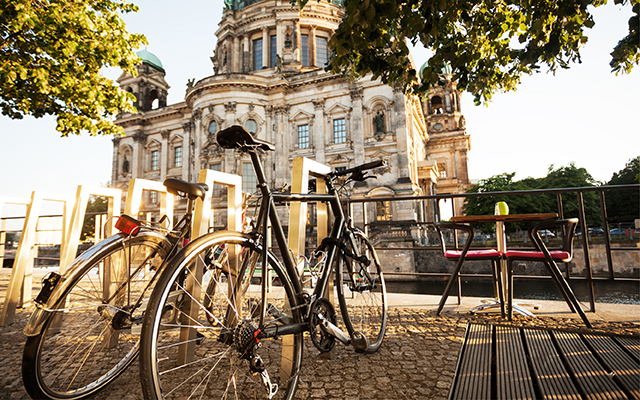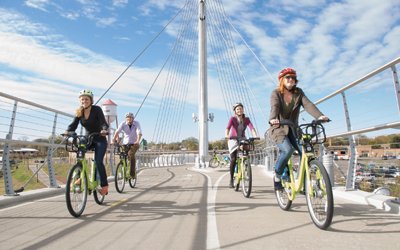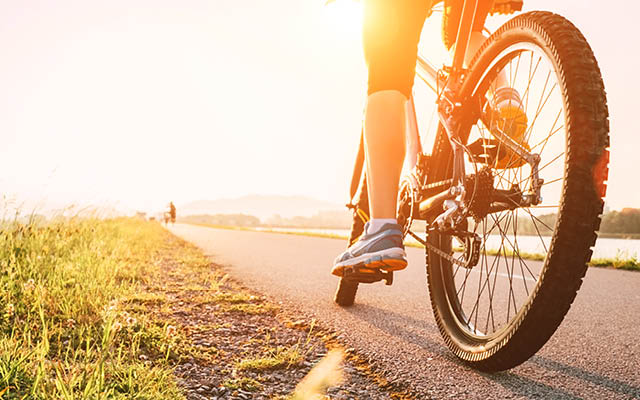We’ve been riding only a few kilometers when my friend Jack and I pull up along one of the bridges crossing Berlin’s Landwehr Canal. “Berlin has more canals than any city in the world, including Venice,” he explains. The capital of Germany, it boasts more than a hundred miles of waterways within its limits and they’re spanned by about 1,700 bridges.
This canal was built between 1845 and 1850 to ease traffic along the River Spree. But today it’s too small for modern cargo ships, so it’s mostly used by kayakers and tour boats carrying sightseers. And by waterfowl. A bevy of swans paddling near the shoreline comes into view, and I’m mesmerized by how the designs created in their wake merge with the shimmer of the sun’s late-morning beams.
The only thing that snaps me out of my trance is Jack’s offer to lead me to a nearby French bakery to get some buttery chocolate patisserie treats.
I finagle my way back onto the slightly too-tall-for-me Minerva — Jack’s vintage racing bike — and we roll back onto the path paralleling the canal. These car-free banks make a perfect thoroughfare for cyclists and pedestrians to travel to and from Kreuzberg and other districts that round the southern half of the city.
We cross more bridges and spin past other cyclists, pedestrians walking their dogs, quaint flats, and colorful farmers’ markets. The charming cafés begin to teem with Germans gathering for Mittagessen (lunch). The aromas of wurst, Spätzle (noodles served with gravy), and Bratkartoffeln (fried potatoes) tickle my nose.
My appetite begins to overwhelm my jet lag, and I kick up my pace, knowing soon I will be biting into an éclair and sipping strong espresso.
A Biking Hub
With its dedicated and extensive cycling network — about 390 miles — Berlin is velo heaven. Its wide streets, flat terrain, and sidewalk bike paths make it one of Europe’s best places to ride. If the massive, overflowing bike racks are any indication, many people do: A recent survey reported that Berliners pedaled their bicycles on as many as one in five of their trips within the city in 2017.
If you don’t have a generous friend who can loan you a spare bike, it’s easy and affordable to rent a Fahrrad at a local shop and even some hotels. Rentals typically range from about $5 to $15 for 24 hours. Berlin also offers a bike-sharing program similar to those in Denver, Minneapolis, New York, and other major U.S. cities. You pay a small annual fee — about $4 — and then an additional $1.25 for each half hour you use a bike. If you plan to cycle in the city for any length of time, however, purchasing a good used bike will save you money in the long run.
I found the two-way sidewalk bike paths wonderful to ride on. I loved the separate lanes for both cars and pedestrians and the helpful bike-specific traffic signals. As you might expect with Germans — who prefer Alles in Ordnung (everything in order) — the system is very efficient. Everyone stayed in their lanes, even during the busiest times of day before and after work.
Unlike urban riding in the United States, biking in Berlin isn’t an extreme sport. There were no potholes, but there were cobblestone streets. The ba-bump, ba-bump, ba-bump of my tires as they thumped along was charming, but after a few days I understood why most locals choose sturdy city bikes over racers such as my Minerva with its skinny tires.
My weeklong biking adventure felt euphoric, but Berliners have higher standards; they’ve been calling for improvements in both safety and access. Thanks to a cycling referendum and a new coalition government focused on sustainable transport, the city is preparing to expand its cycling infrastructure. Officials are planning Autobahn-style protected-bike superhighways — long-distance routes segregated from other vehicles by barriers — that will help cyclists get into, out of, and around the city quicker and safer. A similar bike thoroughfare already exists in Germany’s Ruhr Valley.
Cycling Through History
Berlin is a fairly large city, and exploring it on a bicycle allows you to absorb more of its rich culture than if you were driving or walking. There seems to be something memorable to experience at every turn. I put a foot down whenever I got the chance to gawk at the incredible and abundant street art, tune in to a busking musician, peruse community gardens, or pop into one of the city’s numerous Plattenläden (vinyl shops). In other words, I stopped a lot.
Old factories have been turned into nightclubs, artist lofts, and music venues. One of my favorite sections of the city featured a series of refashioned warehouses that house a skate park and a climbing gym — der Kegel — that features indoor and outdoor bouldering options including “the cone,” a 61-foot-tall concrete tower that challenges climbers of all skill levels.
A history buff, I was happy to be rolling through a locale marked by such a unique past —imperialism, bombardment, division, and reunification.
Pedal around the city, for example, and you’ll notice double rows of cobblestones marking where the Berlin Wall once stood. Those looking for a longer journey and deeper dive into life during partition can cycle the entire 99-mile Berliner Mauerweg. However, a designated 3.5-mile cycling route in the heart of the city passes memorials, former watchtowers, and free, open-air museums featuring original Wall remnants.
When you need a snack, lock up your bike and enjoy a bratwurst, gelato, or fresh-squeezed Spanish Valencia Orangensaft (juice) from one of the city’s many food kiosks. Or wander through the Turkish Market.
If you direct your gaze toward the sky, you’ll spy the stainless-steel dome of Berlin’s tallest building — the Fernsehturm (television tower) — from just about anywhere in the city. Some have argued that the former German Democratic Republic built it as a symbol of its power over the West, though the GDR also saw its construction as an opportunity to create a useful transmitter.
And every cyclist needs to experience Tempelhof. This decommissioned airport featured one of Europe’s largest buildings in the 1930s; it was used during World War II for arms production and later as a drop point for supplies during the 1948–1949 Berlin Airlift. In 2010 the city turned the runways into a giant track for cycling and in-line skating. The fields are now a massive public park. One hangar houses a museum with artifacts from World War II Allied forces. And, of course, there’s also a Biergarten. Prost!
In addition to the refurbished structures, Berlin features an array of memorials and museums for exploring nearly everything related to its history. But you don’t have to visit a special place and pay a fee to experience the past.
Look carefully at the buildings and you’ll probably see at least one that’s pockmarked from bullets that flew during the Battle of Berlin. Or pause to read the names on plaques placed at the last known addresses of Jewish Holocaust victims. It might trigger powerful emotions, but if Berlin taught me anything, it’s the importance of remembering. I’m glad I got to experience all of it up close.
This originally appeared as “Let the Good Times Roll” in the July/August 2018 print issue of Experience Life.
Wheel Fun
If Europe is too far to travel, cycle around one of these hidden stateside gems.
Fort Collins, Colo.
This is the first city I explored exclusively on two wheels. But nostalgia isn’t the only reason it remains one of my favorite towns for cycling.
Meandering along the Poudre River Trail to Spring Creek Trail will probably make you forget you’re even in a city. Once you’ve had your fresh-air fix, grab a pint at one of the numerous craft breweries, such as Odell, Funkwerks, or employee-owned stalwart New Belgium. Or design your own bike-friendly pub crawl.
Salt Lake City, Utah
Most lists of top biking cities don’t include the capital of the Beehive State, but it has a lot to offer a cyclist, including flat topography, wide streets laid out in a simple grid, and stunning views of the Wasatch and Oquirrh mountain ranges.
If you’re looking for a chance to stop and smell the flowers, make the short climb into the foothills and visit Red Butte Garden. On a summer evening, pack a picnic and blanket in your pannier and settle in the amphitheater to hear music from big-name acts showcased in the Garden’s popular concert series (Wilco, Trombone Shorty, and Bonnie Raitt have all performed here).
Eugene, Ore.
While not as well known among cycling enthusiasts as Portland, this lively college town is another great Oregon city to explore by bike. Rolling along the picturesque Willamette River Trail is a must.
When you’re ready for a break, stop by the famous Saturday market that runs — rain or shine — from early April through early November. Each week, farmers and artisans gather to sell their locally grown food and handmade wares while bluegrass musicians play on the market stage.




This Post Has 0 Comments